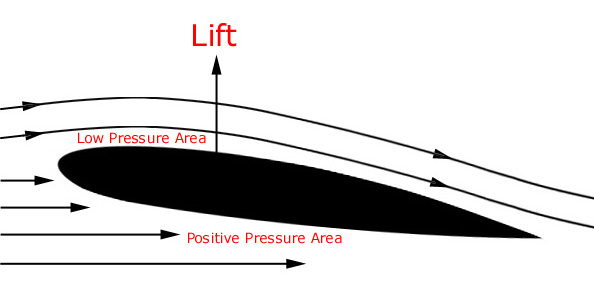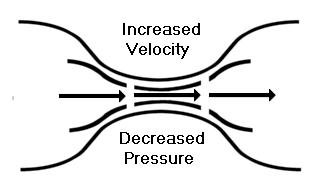
|
 |
||||||
|---|---|---|---|---|---|---|---|
| Airfoils and Lift |
 |
 |
 |
 |
 |
||
 |
 |
 |
 |
 |
|||
 |
||
|
An airfoil is a device which gets a useful reaction from air moving over its surface. When an airfoil is moved through the air, it is capable of producing lift. Wings, horizontal tail surfaces, vertical tails surfaces, and propellers are all examples of airfoils.

Generally the wing of small aircraft will look like the cross-section of the figure above. The forward part of an airfoil is rounded and is called the leading edge. The aft part is narrow and tapered and is called the trailing edge. A reference line often used in discussing airfoils is the chord, an imaginary straight line joining the extremities of the leading and trailing edges.

Bernoulli's Principle: To understand how lift is produced, we must examine a phenomenon discovered many years ago by the scientist Bernoulli and later called Bernoulli's Principle: The pressure of a fluid (liquid or gas) decreases at points where the speed of the fluid increases. In other words, Bernoulli found that within the same fluid, in this case air, high speed flow is associated with low pressure, and low speed flow with high pressure. This principle was first used to explain changes in the pressure of fluid flowing within a pipe whose cross-sectional area varied. In the wide section of the gradually narrowing pipe, the fluid moves at low speed, producing high pressure. As the pipe narrows it must contain the same amount of fluid. In this narrow section, the fluid moves at high speed, producing low pressure. An important application of this phenomenon is made in giving lift to the wing of an airplane, an airfoil. The airfoil is designed to increase the velocity of the airflow above its surface, thereby decreasing pressure above the airfoil. Simultaneously, the impact of the air on the lower surface of the airfoil increases the pressure below. This combination of pressure decrease above and increase below produces lift. Probably you have held your flattened hand out of the window of a moving automobile. As you inclined your hand to the wind, the force of air pushed against it forcing your hand to rise. The airfoil (in this case, your hand) was deflecting the wind which, in turn, created an equal and opposite dynamic pressure on the lower surface of the airfoil, forcing it up and back. The upward component of this force is lift; the backward component is drag. |
Return to Aircraft Theory Index
© The Aviation History Online Museum. All rights reserved.
Created March 18, 2007. Updated June 1, 2015.